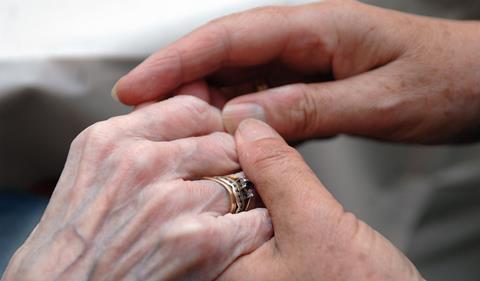Personalised care charts provide an instant and reliable means of transmitting information when patients are unable to communicate themselves, says Zoe Harris

A very specific incident led me to search for a reliable method of sharing information with health and social care professionals about a person when they are unable to communicate.
My husband, living with advanced dementia, developed a tendency to tip his chair over backwards, the illness having affected his sense of balance.
‘This is about enabling a relationship to develop and empathy to grow’
When he moved into a care home, the fact that his chair needed to be pushed up against the wall to keep him safe was in his care plan, and I also made a point of telling all carers that this was the case.
However, someone decided to move his chair more into the room, apparently unaware of why it needed to stay where it was, and soon after I got the phone call to say Geoff had taken a tumble.
As upset as I was at the time, there was not really anybody to blame, it was just the system. It is called learning on the job. It would not happen again but it did not have to happen at all.
- Lessons from Japan: Tackle the dementia challenge by supporting carers
- Five ways to ensure progress in dementia care
- We pharmacists are tackling dementia in our communities
Light bulb moment
However, the real light bulb moment occurred when a carer came into Geoff’s room while I was visiting.
She glanced at the information on the wall chart I had created. “I didn’t know you had seven grandchildren, Geoff,” she exclaimed.
‘Research confirms that where empathy exists, standards of care will be higher’
In that instant he was transformed in her eyes from a list of jobs, a body that needed washing, dressing and feeding, to a human being with history, experience of life, and a family.
This was not just about sharing information to prevent mistakes, it was about enabling a relationship to develop and, from that, empathy to grow.
Research confirms that where empathy exists, standards of care will be higher.
Case studies: Twist-N-View charts
Peninsula Community Health
Peninsula Community Health provides NHS adult community health services to local people in Cornwall and the Isles of Scilly.
The organisation was looking for a way to ensure that people were treated as individuals and not as a clinical condition.
It understood this to be a crucial element of meeting the individual needs of patients but recognised that, in order to offer that quality of care, it had to find a way of ensuring that staff had the information they needed about each patient.
The Twist-N-View care chart allowed it to make information available for the whole multidisciplinary team, and when the information was not needed the chart could be turned to the wall.
Peninsula introduced one to one educational interactive sessions to communicate the importance of personalisation of care to staff. It explained how the charts could be used to ensure that important conversations with the patient and the carer or family member could lead to better understanding of an individual’s needs.
The care charts gave all levels of staff opportunities to interact with patients, even those who may have previously felt reluctant to engage in conversation.
They allowed them to go beyond just a list of likes and establish what was important to people.
They were also able to understand what could be done to manage difficult situations that may arise, for instance what to do if someone with dementia became agitated or confused.
Peninsula developed a culture where all staff members - whether healthcare assistants, housekeepers, therapy support staff or general service assistants - are encouraged to be a part of the care delivered to patients.
Because the charts helped Peninsula to fully understand the individual needs of its patients, it was able to reduce the length of their stays in hospital.
It also recorded a reduction in the number of complaints and inappropriate referrals.
Peninsula has implemented Twist-N-View care charts in all 14 of its community hospitals.
Epsom Hospital
Epsom Hospital, part of the Epsom and St Helier University Hospitals Trust, has also chose to use the Twist-N-View care chart, but to meet its requirements has chosen the display version, which allows it to insert a picture of a forget-me-not into the clear front pocket.
Like Peninsula, Epsom includes the charts in its training so everyone from porters to consultants is aware of the significance of the bright blue flower, and that information about a patient can be found on the reverse.
Soon after the charts were introduced and families were encouraged to complete a chart for their relative, the positive comments started to flow.
“Nursing staff realised that the charts gave them the ability to engage much more quickly with a patient who might not be able to communicate reliably,” says Sue Cook, team leader of the Older Persons Assessment and Liaison for Dementia.
“Information is immediately available to them,” she added. “It gives non-nursing staff like porters an opportunity to open a conversation with the patient, when before they wouldn’t have access to simple information like their favourite foods, or important people in their lives, what they do or did for a living.”
Empathic approach
That instant and reliable transmission of information is just as feasible - and perhaps even more important - in hospital settings.
In this environment, staff do not have the luxury of time to develop that all important relationship; they need to treat the person and discharge them as quickly as possible.
It is well understood that a person with dementia should spend no longer than necessary in what are likely to be bewildering surroundings.
‘Staff do not have the luxury of time to develop that all important relationship’
But while they are there, an informed and empathic approach from all members of staff interacting with them from the outset can have a significant influence on the wellbeing of the patient.
Andrea Sutcliffe, chief inspector of adult social care for the Care Quality Commission, learned this lesson when, still in her teens, she worked as a cleaner in the NHS for a summer.
She saw the impact a kind word, or a smile at the right time, could have for someone at their most vulnerable.
“I remember one woman saying that I was the only person who had been nice to her all day - I had not done much but it had meant a lot to her,” Ms Sutcliffe says.
Imagine a culture where her supervisor at the time had encouraged such behaviour, instead of scolding her employee for doing something that was “not your job”.
Both Peninsula Community Health and Epsom Hospital (see case studies) are including all staff in their dementia training, encouraging them to converse with patients, even those who do not have a “caring” role.
At a glance
Using a tool such as the Twist-N-View care chart, a person’s needs and preferences are presented as an entirely separate set of information, effectively giving permission to staff who would not wish to delve into a patient’s notes, and it encourages families to get involved as well.
In order to improve outcomes for people with dementia, it is vital that the culture in every care setting recognises:
- the importance of collecting information about a person;
- the need for an inclusive whole team approach; and
- the requirement for robust procedures to ensure that the information can quickly and easily be accessed.
Only then can a person with dementia be confident that their mental, emotional and social needs, as well as their physical needs, will be met.
Zoe Harris, one of HSJ’s Top Innovators 2014, is founder and director of Care Charts UK, a not for profit social enterprise which designs communication tools to assist in the care of people living with dementia.



























1 Readers' comment